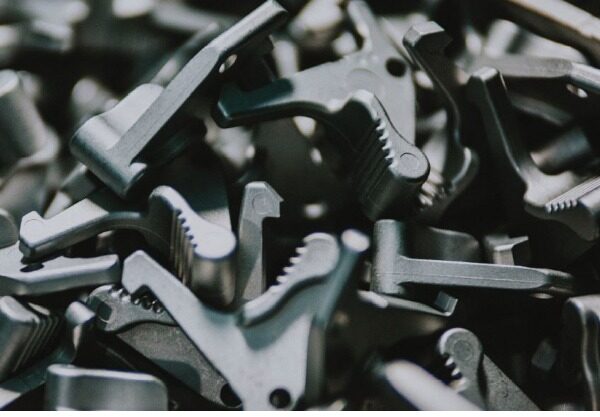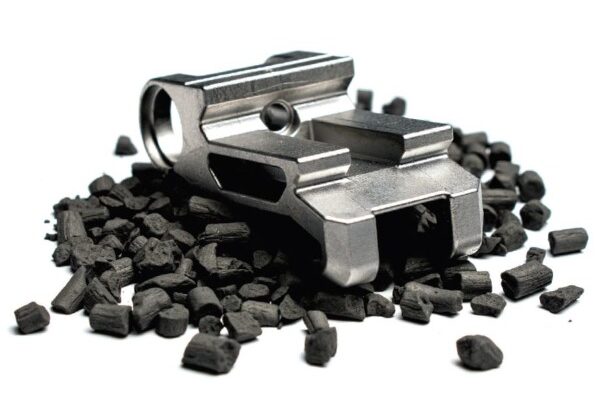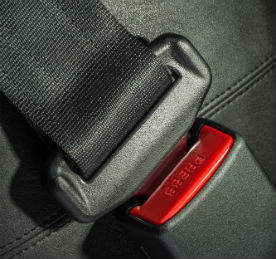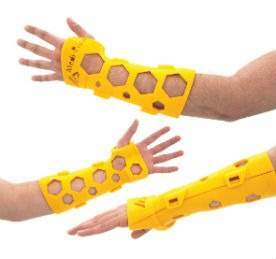
Covid-19 has impacted many industries, but very few companies have felt it quite as sharply as medical device manufacturers. And, as if the pandemic wasn’t enough on its own, over the past 12 months we’ve seen a cargo ship splayed sideways in a canal, a hacked pipeline and global raw material shortages. It’s no surprise that supply chain risk is the major topic of conversation. While pushing the demand for singleuse devices – which require less cleaning and remove the risk of infecting patients – into overdrive, the pandemic has made them considerably harder to source.
Enter metal injection moulding (MIM), which combines the most useful characteristics of powdered metallurgy and plastic injection moulding to facilitate the production of small, complex-shaped metal components with outstanding mechanical properties. It’s a green technology built around specialists with the ability and metallurgical expertise to formulate feedstocks in-house, which means it doesn’t rely on fragile global supply chains, greatly lowering risk for OEMs. Moreover, MIM is perfect for producing single-use devices because of its ability to meet the higher volume requirements of complex geometries at a lower price point. That’s not all. MIM can support a wide variety of medical device applications. These include dental/orthodontic brackets and devices, surgical devices, orthopaedic components, delivery systems and robotic surgery tools, among others. Stainless steels are the most common alloys and they are often used to reduce component costs for single-use devices where contact with patients is limited. Advancements have also been made to utilise bio-implantable cobalt-chrome alloys such as MIM F75 (ASTM A2886) and MIM MP35N (ASTM F562) as a costeffective alternative to titanium.
The MIM process
So, how does MIM work? Well it begins with the compounding of feedstock, which is a mixture of powdered metal alloys and polymer binders. The feedstock is then injected into a mould that is designed very similarly to plastic injection moulding equipment. Once injected into the mould, a ‘green’ part is formed, which is, on average, 20% larger than the final component geometry due to the added binding agent.
The component then goes to the first debinding stage. The process utilised during this stage may change depending on the binding agent used. There are two common processes for first stage debinding: thermal and solvent.
After the first stage of debinding, the component is called a ‘brown’ part. The brown part is then prepped for the final sintering stage. To prep the component for sintering, flash is often cleaned and the components may be placed on sintering fixtures to combat distortion.
The MIM sintering stage is where the brown parts are placed in a high temperature furnace. The part is heated near its melting point, all the remaining binder is completely removed and the metal particles are bonded together. The part then shrinks and densifies until it reaches its final strength and geometry.
Depending on the component’s end-use and specification, secondary operations may be performed to improve the mechanical properties, dimensional control and machine features, as well as to add surface finishes.
The art of MIM
Whether they’re needed to minimise supply chain risk or provide the optimal medical device components, strong metallurgical expertise is a baseline for the top MIM manufacturers. This expertise is important for sourcing appropriate raw materials, and developing the strong moulding and sintering processes required for the production of high-quality components. MIM suppliers are also required to have strong scientific problem-solving and metrology skills.
The art of metal injection moulding also allows for a design freedom that may not be possible through other manufacturing methods. MIM tooling can form very complex geometries that would be expensive to machine. Even if the geometry is able to be machined, scaling may be difficult without a large investment. By contrast, one MIM tool can produce anywhere between one and one million components with relative ease. The mechanical properties of MIM are also very good. MIM components can achieve greater than 97% density on average and can stand up to the rigorous requirements of medical device manufacturers.
However, one disadvantage to MIM is dimensional tolerancing. As a rule of thumb, MIM can hold +/-0.5% of the dimension. To overcome this, secondary operations such as machining and coining may be performed. The surface finish of MIM components is also slightly less polished than that of machined components. On average, MIM can achieve finishes of 0.8–1μm.
Nonetheless, MIM can process a wide variety of materials and can even be used to manufacture them in the same mould simultaneously. These alloys range from carbon steels, tool steels, stainless steels and bio-implantable steels, to soft-magnetic alloys, tungsten heavy alloys, copper and titanium. Each alloy can serve a specific purpose depending on the application. Raw material specification and powder size is extremely important to developing and manufacturing high-quality MIM components. If the metal powder is available in the appropriate size (less than 25μm) and it sinters to a sufficiently high density, then the material can be manufactured using the MIM process.
By design
Speed is of the essence when the goal is saving lives. Rapid prototyping has been shown to be perhaps just as important to the medical device industry as single-use devices. It’s also an ideal fit with MIM, and many of the top MIM manufacturers are utilising metal 3D printing technology for early design testing and MIM experiments. Metal 3D printing can be used to get rapid prototypes in the hands of engineers without the up front cost of tooling. Binderjet 3D printing is one of the two primary technologies. APP’s proprietary version uses MIM powders and sintering furnaces to create prototype components. The overlap in equipment and technology allows for testing during the component development stage as the prototype components meet the mechanical properties of standard MIM components.

Many medical device manufacturers rely on the expertise of MIM suppliers to design components specific for the MIM process. Design for manufacturing performed by MIM experts can help alleviate component geometry risk. During the design phase, experts review tooling design, component mouldability and part geometry.
When designing a MIM part, there are a few key aspects that must be considered. The first is part geometry. Taking some time to consider how a part will be set during sintering is important. If possible, try to avoid geometries that overhang, as these create difficulties when setting parts. Consider designing a part with a flat area for setting to decrease cost. When it’s done with that in mind, the MIM process creates parts with near-wrought properties and unmatched density. This is a key benefit over pressed metal parts. MIM parts also exhibit mechanical properties that are on par with wrought or forged parts.
The metal injection moulding market has grown around 6% annually and is becoming more widely accepted among engineering and supply chain professions. It will continue to grow as more and more companies push for single-use and micro components.
Other types of injection moulding
Much like consumer products, medical device technology is becoming smaller as manufacturing becomes more advanced, largely thanks to the flexibility of injection moulding processes.
Peter Littlejohns from Medical Device Developments’ online partner, NS Medical Devices, gives an overview of the technology’s other applications.
Thin wall moulding
Thin walls can be both a functional benefit and a way to improve patient comfort when it comes to certain medical devices. The term itself simply means creating the walls of a device in a way that makes them thin relative to the whole piece, but in practice this tends to mean walls thinner than 1mm. The technique requires regular injection moulding equipment, but in order for walls to retain their structural integrity as they are created thinner, the base materials used tend to be plastics like LCP, polypropylene and nylon – although silicone and metal can also be moulded this way.
Materials will depend on the device being produced and will have undergone testing at different levels of physical pressures and temperatures to ensure they can do the job. Thin walls are often found in wearable devices and micro surgical tools, but can also be used in invasive equipment like catheter ablation tools and endoscopes.
Gas-assisted injection moulding
When parts are created with regular injection moulding, there’s a risk that sink marks can occur, making the final product look unsightly and potentially weakening its structure. The reason this happens is because thick areas of a mould cool more slowly than thin ones when the resin is injected, and without enough pressure to pack these areas tightly against the walls, the uneven distribution can cause a sunken appearance.
Gas-assisted injection moulding is used to solve this issue by running gas (usually nitrogen) through channels built into the mould. The gas carves a hollow path through the middle of these thicker sections and creates the pressure needed to force the resin tightly against the walls of the mould, creating a smooth part that is structurally sound with no sink marks. This method is used to create complex parts without any visual blemishes, but because the pressure exerted by the gas lessens if it doesn’t flow in a relatively straight line, it isn’t recommended for parts with sharp corners in their design.
Liquid silicone injection moulding
While surface-borne infection is a general concern in hospitals, some medical devices have a greater need to remain hygienic than others, like tubes and respiratory masks.
Liquid silicone injection moulding is used for devices like these because of the chemical resistance of the rubber-like substance produced using this method. It also uses a clean production room so that no ambient air makes contact with the mould, preventing dust and moisture from getting into the mixture as it sets.
Another benefit is that silicone is biologically inert, meaning it doesn’t react with biological tissue and can be implanted safely in the body. The basic raw material for silicone rubber is sand, or silicon dioxide, which is processed into pure silicon and reacted with methyl chloride, after which a range of processing steps are used depending on the properties desired for the silicone.
https://advancedpowderproducts.com/






